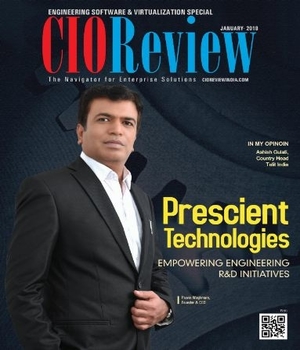
Role of IoT in Automotive 4.0
Ashish Gulati, Country Head, Telit India | Wednesday, 27 December 2017, 06:26 IST
 The Internet of Things (IoT) is changing the world rapidly in a connecting manner. The world is getting smaller and smaller by connecting things. There is no business in the world which is untouched by the IoT wave of connectivity. We’ve already seen that IoT is creating a considerable impact on health care, agriculture, retail and it's already started influencing the approach we tend to our cars while purchasing and driving them. Industry 4.0 assembling is about the expanding network of smaller and smaller segments. Cooperation between machines, items, individuals, procedures, processes and endeavors which triggers positive change at each level.
The Internet of Things (IoT) is changing the world rapidly in a connecting manner. The world is getting smaller and smaller by connecting things. There is no business in the world which is untouched by the IoT wave of connectivity. We’ve already seen that IoT is creating a considerable impact on health care, agriculture, retail and it's already started influencing the approach we tend to our cars while purchasing and driving them. Industry 4.0 assembling is about the expanding network of smaller and smaller segments. Cooperation between machines, items, individuals, procedures, processes and endeavors which triggers positive change at each level.
The IoT empowers transformational change, and there is no doubt that the auto sector is changing to a great degree at a very quick pace. IoT-related advances will draw a map for the business to follow, and the connected cars will assume a noteworthy part on the streets and in the economy without bounds. Connected cars and IoT offer numerous opportunities for both consumer and automotive manufactures. For consumers, connected cars means integration with entertainment, traffic and navigation information and advanced features such as remote diagnostics and maintenance, safety and emergency assistance. For manufacturers, connected cars and telematics enable valuable insights into vehicle operations and performance, remote diagnostics, safety services for the lifetime of a vehicle and create better contact with customers.
Advancement of driverless, the ultimate expression of a car that drives itself is being developed through IoT. Such a car would be 10% equipment and 90% programming. It would be connected with everything - from vehicle to vehicle, vehicle to cloud and vehicle to driver. Cars would be connected without the direct involvement of the driver, through the help of software that is still in the process of being perfected. Such a move would be an awesome thing for individuals who abhor driving. Consequently, vehicles are not just going to be all about driver comfort and super ergonomics, there would a new era where you can see driverless cars all around. Connected Cars will turn into a hub of infotainment information and excitement which would meet IoT to make a very surprising background for the user. In future, vehicles will come implanted with telematic arrangements that would make driving a delight. The driver would have applications on the dashboard that would give him/her ongoing excursion reports, activity reports, hand signal sensors to help counteract mishaps, speech to text functionality to prevent the woes of typing, most recent gaming frameworks to provide in-car gaming and Wi-Fi hotspots.
One of the biggest advantages of driverless car is safety. According to WHO, worldwide 1.24 million people die each year in road accidents and as many as 50 million are injured. Human error causes over 90 percent of these collisions. Driverless cars, which can sense other vehicles on the road as well as obstacles and lane markings, are already proving much safer than human-driven cars. Driverless cars use a mix of GPS, cameras, complex scanners and sensors to detect vehicles, traffic signals, curbs, pedestrians and other obstacles. Vehicle data can be used to create safer, more personalised automotive journeys. Improved vehicle safety and greater driving experience. The increase in the number of connected cars will not only help the automotive industry but also the suppliers and consumers. The increase in consumption for connected cars would pave the way for new opportunities for designers, app developers and web developers. Of course, the initial milestone will focus on car-to-mobile connection, but this will eventually spread to vehicle-to-vehicle and then vehicle-to-infrastructure connection. Connected cars will also provide real-time monitoring of the vehicle’s status and operation. Tracking of the vehicle in the event of car-jacking and alerts to safeguard the driver and relatives. Remote control of the vehicle in countries where this is allowed by law. Optimization of routes and driving expenses. For all this to happen globally some road safety laws have to change. For example, as per the European law “Only those vehicles can come on the road which has a human sitting behind the steering”.
The connected automotive sector is a growing sector in India and expected to grow exponentially in the coming years. Connected cars are a major element of IoT revolution globally. According to Gartner, the global connected car production will grow almost 10-fold in five years - from 12.4 million in 2016to 61 million in 2020.
Connected cars have exploded thanks to IoT. As of now, automakers are interfacing their vehicles in two ways: embedded and tethered. Embedded autos utilize a built-in antenna and chipset, while tethered autos use hardware to enable drivers to interface with their cars by means of their cell phones. Moreover, app integration is becoming commonplace in today's vehicles. Google Maps and other route devices have started to supplement work in GPS frameworks. Applications, for example, GasBuddy demonstrate the driver where he or she can locate the cheapest fuel in their local area. Music applications, for example, Spotify remove the need for traditional or even satellite radio.
Soon the Autonomous driving will become the norm. Driverless cars will change the experience of driving completely in the coming years. Government as well as private sectors will play a major role in it. Future techniques of the auto companies should concentrate on increased environmental safety concerns, rising fuel prices and cost-effectiveness. Innovation has to focus on increasing efficiency and reducing emissions. IoT will become a significant player in the auto industry because of its ability to benefit customers, manufacturers, dealers and the whole eco-system.
CIO Viewpoint
Digital Transformation In Manufacturing
By Jacob Peter, Head IT, Bosch Engineering and Business Solutions
When Technology Meets the World of Financial...
By Vamsi Krishna Ithamraju, Group IT Head, CreditAccess Asia
By Daljit Singh Sodhi, Associate Director-IT at KPMG India
CXO Insights
4 Steps to Lean in Industry 4.0
By Joe Panebianco, Director of Manufacturing Engineering, Tekni-Plex, Inc.
Standing at the Crossroad of Lean Manufacturing...






